Strategic Management Application
VerifiedAdded on 2020/01/07
|16
|4407
|208
Essay
AI Summary
This assignment delves into the realm of strategic management within the context of animal production science. It requires students to demonstrate their understanding of key concepts, such as Porter's Five Forces model, and apply them to real-world scenarios in the animal industry. The assignment emphasizes the importance of strategic decision-making for success in this field.
Contribute Materials
Your contribution can guide someone’s learning journey. Share your
documents today.
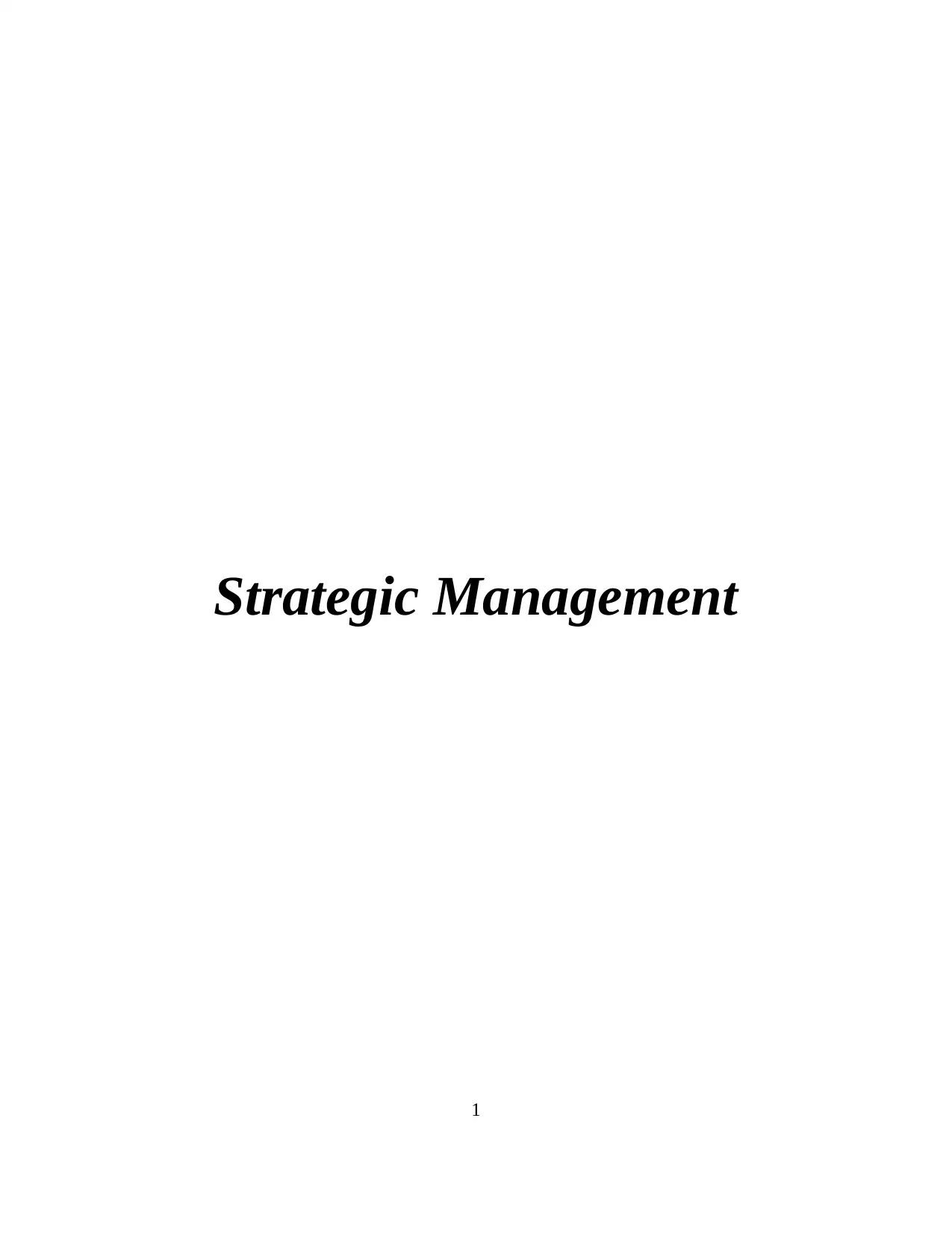
Strategic Management
1
1
Secure Best Marks with AI Grader
Need help grading? Try our AI Grader for instant feedback on your assignments.
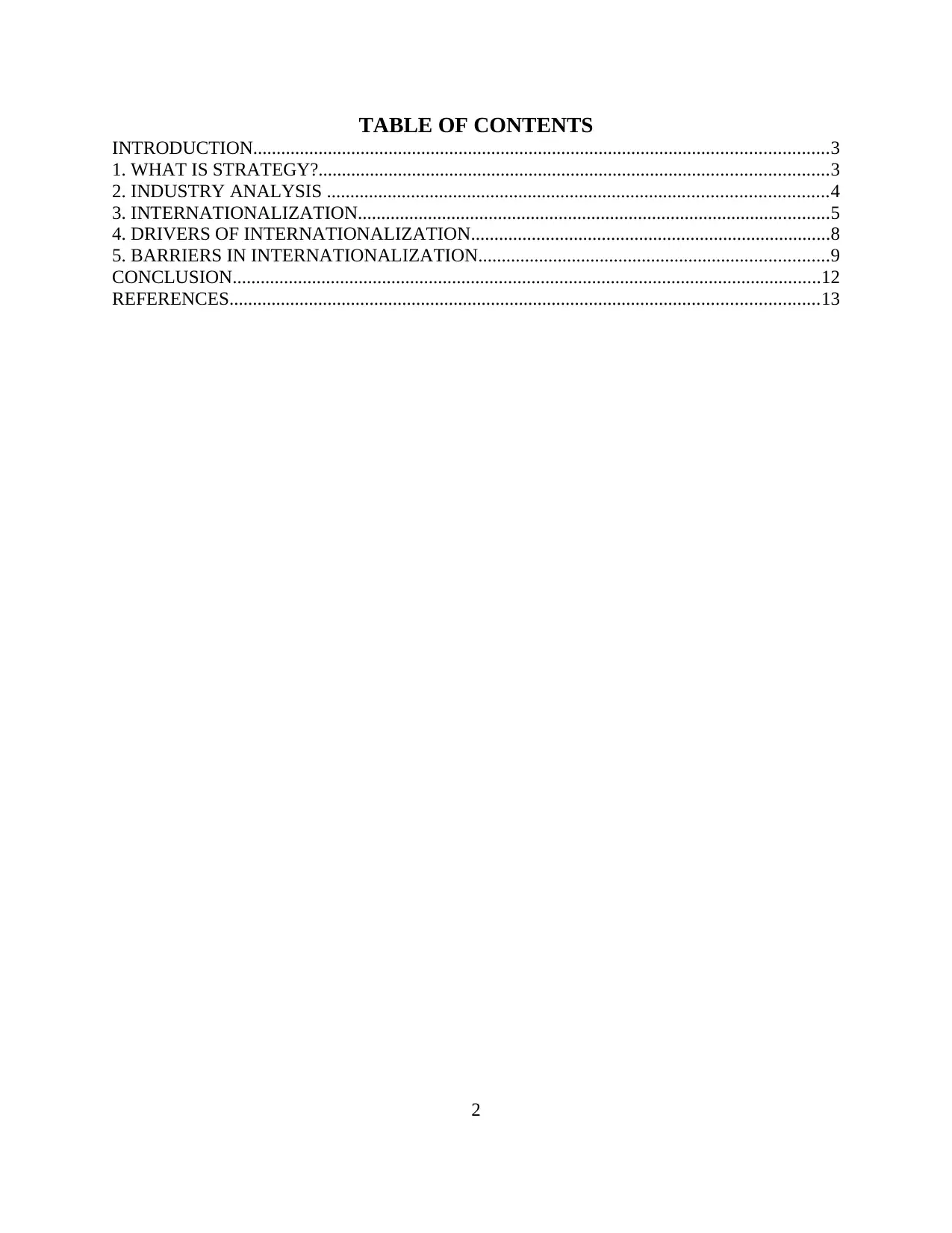
TABLE OF CONTENTS
INTRODUCTION...........................................................................................................................3
1. WHAT IS STRATEGY?.............................................................................................................3
2. INDUSTRY ANALYSIS ...........................................................................................................4
3. INTERNATIONALIZATION.....................................................................................................5
4. DRIVERS OF INTERNATIONALIZATION.............................................................................8
5. BARRIERS IN INTERNATIONALIZATION...........................................................................9
CONCLUSION..............................................................................................................................12
REFERENCES..............................................................................................................................13
2
INTRODUCTION...........................................................................................................................3
1. WHAT IS STRATEGY?.............................................................................................................3
2. INDUSTRY ANALYSIS ...........................................................................................................4
3. INTERNATIONALIZATION.....................................................................................................5
4. DRIVERS OF INTERNATIONALIZATION.............................................................................8
5. BARRIERS IN INTERNATIONALIZATION...........................................................................9
CONCLUSION..............................................................................................................................12
REFERENCES..............................................................................................................................13
2
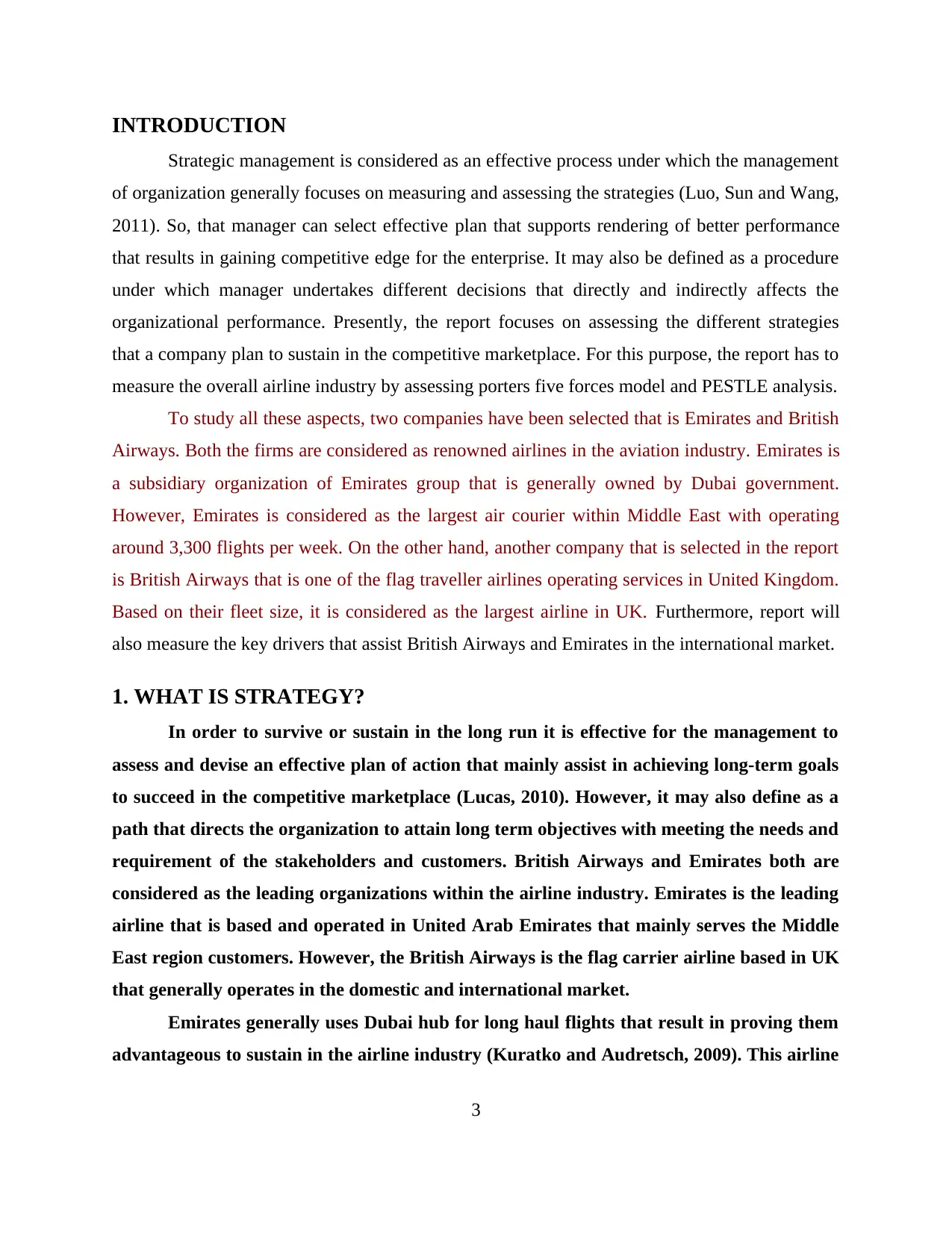
INTRODUCTION
Strategic management is considered as an effective process under which the management
of organization generally focuses on measuring and assessing the strategies (Luo, Sun and Wang,
2011). So, that manager can select effective plan that supports rendering of better performance
that results in gaining competitive edge for the enterprise. It may also be defined as a procedure
under which manager undertakes different decisions that directly and indirectly affects the
organizational performance. Presently, the report focuses on assessing the different strategies
that a company plan to sustain in the competitive marketplace. For this purpose, the report has to
measure the overall airline industry by assessing porters five forces model and PESTLE analysis.
To study all these aspects, two companies have been selected that is Emirates and British
Airways. Both the firms are considered as renowned airlines in the aviation industry. Emirates is
a subsidiary organization of Emirates group that is generally owned by Dubai government.
However, Emirates is considered as the largest air courier within Middle East with operating
around 3,300 flights per week. On the other hand, another company that is selected in the report
is British Airways that is one of the flag traveller airlines operating services in United Kingdom.
Based on their fleet size, it is considered as the largest airline in UK. Furthermore, report will
also measure the key drivers that assist British Airways and Emirates in the international market.
1. WHAT IS STRATEGY?
In order to survive or sustain in the long run it is effective for the management to
assess and devise an effective plan of action that mainly assist in achieving long-term goals
to succeed in the competitive marketplace (Lucas, 2010). However, it may also define as a
path that directs the organization to attain long term objectives with meeting the needs and
requirement of the stakeholders and customers. British Airways and Emirates both are
considered as the leading organizations within the airline industry. Emirates is the leading
airline that is based and operated in United Arab Emirates that mainly serves the Middle
East region customers. However, the British Airways is the flag carrier airline based in UK
that generally operates in the domestic and international market.
Emirates generally uses Dubai hub for long haul flights that result in proving them
advantageous to sustain in the airline industry (Kuratko and Audretsch, 2009). This airline
3
Strategic management is considered as an effective process under which the management
of organization generally focuses on measuring and assessing the strategies (Luo, Sun and Wang,
2011). So, that manager can select effective plan that supports rendering of better performance
that results in gaining competitive edge for the enterprise. It may also be defined as a procedure
under which manager undertakes different decisions that directly and indirectly affects the
organizational performance. Presently, the report focuses on assessing the different strategies
that a company plan to sustain in the competitive marketplace. For this purpose, the report has to
measure the overall airline industry by assessing porters five forces model and PESTLE analysis.
To study all these aspects, two companies have been selected that is Emirates and British
Airways. Both the firms are considered as renowned airlines in the aviation industry. Emirates is
a subsidiary organization of Emirates group that is generally owned by Dubai government.
However, Emirates is considered as the largest air courier within Middle East with operating
around 3,300 flights per week. On the other hand, another company that is selected in the report
is British Airways that is one of the flag traveller airlines operating services in United Kingdom.
Based on their fleet size, it is considered as the largest airline in UK. Furthermore, report will
also measure the key drivers that assist British Airways and Emirates in the international market.
1. WHAT IS STRATEGY?
In order to survive or sustain in the long run it is effective for the management to
assess and devise an effective plan of action that mainly assist in achieving long-term goals
to succeed in the competitive marketplace (Lucas, 2010). However, it may also define as a
path that directs the organization to attain long term objectives with meeting the needs and
requirement of the stakeholders and customers. British Airways and Emirates both are
considered as the leading organizations within the airline industry. Emirates is the leading
airline that is based and operated in United Arab Emirates that mainly serves the Middle
East region customers. However, the British Airways is the flag carrier airline based in UK
that generally operates in the domestic and international market.
Emirates generally uses Dubai hub for long haul flights that result in proving them
advantageous to sustain in the airline industry (Kuratko and Audretsch, 2009). This airline
3
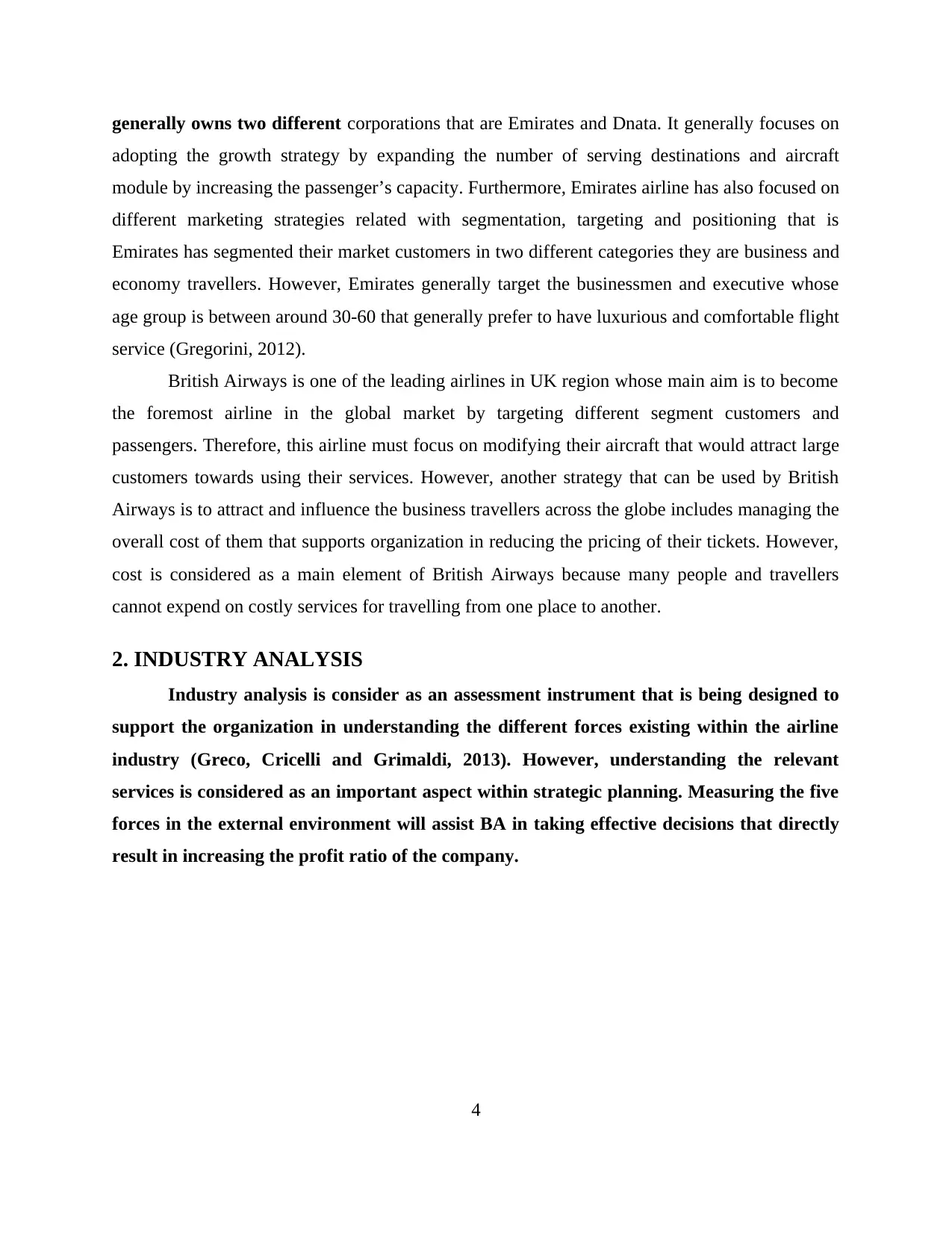
generally owns two different corporations that are Emirates and Dnata. It generally focuses on
adopting the growth strategy by expanding the number of serving destinations and aircraft
module by increasing the passenger’s capacity. Furthermore, Emirates airline has also focused on
different marketing strategies related with segmentation, targeting and positioning that is
Emirates has segmented their market customers in two different categories they are business and
economy travellers. However, Emirates generally target the businessmen and executive whose
age group is between around 30-60 that generally prefer to have luxurious and comfortable flight
service (Gregorini, 2012).
British Airways is one of the leading airlines in UK region whose main aim is to become
the foremost airline in the global market by targeting different segment customers and
passengers. Therefore, this airline must focus on modifying their aircraft that would attract large
customers towards using their services. However, another strategy that can be used by British
Airways is to attract and influence the business travellers across the globe includes managing the
overall cost of them that supports organization in reducing the pricing of their tickets. However,
cost is considered as a main element of British Airways because many people and travellers
cannot expend on costly services for travelling from one place to another.
2. INDUSTRY ANALYSIS
Industry analysis is consider as an assessment instrument that is being designed to
support the organization in understanding the different forces existing within the airline
industry (Greco, Cricelli and Grimaldi, 2013). However, understanding the relevant
services is considered as an important aspect within strategic planning. Measuring the five
forces in the external environment will assist BA in taking effective decisions that directly
result in increasing the profit ratio of the company.
4
adopting the growth strategy by expanding the number of serving destinations and aircraft
module by increasing the passenger’s capacity. Furthermore, Emirates airline has also focused on
different marketing strategies related with segmentation, targeting and positioning that is
Emirates has segmented their market customers in two different categories they are business and
economy travellers. However, Emirates generally target the businessmen and executive whose
age group is between around 30-60 that generally prefer to have luxurious and comfortable flight
service (Gregorini, 2012).
British Airways is one of the leading airlines in UK region whose main aim is to become
the foremost airline in the global market by targeting different segment customers and
passengers. Therefore, this airline must focus on modifying their aircraft that would attract large
customers towards using their services. However, another strategy that can be used by British
Airways is to attract and influence the business travellers across the globe includes managing the
overall cost of them that supports organization in reducing the pricing of their tickets. However,
cost is considered as a main element of British Airways because many people and travellers
cannot expend on costly services for travelling from one place to another.
2. INDUSTRY ANALYSIS
Industry analysis is consider as an assessment instrument that is being designed to
support the organization in understanding the different forces existing within the airline
industry (Greco, Cricelli and Grimaldi, 2013). However, understanding the relevant
services is considered as an important aspect within strategic planning. Measuring the five
forces in the external environment will assist BA in taking effective decisions that directly
result in increasing the profit ratio of the company.
4
Secure Best Marks with AI Grader
Need help grading? Try our AI Grader for instant feedback on your assignments.
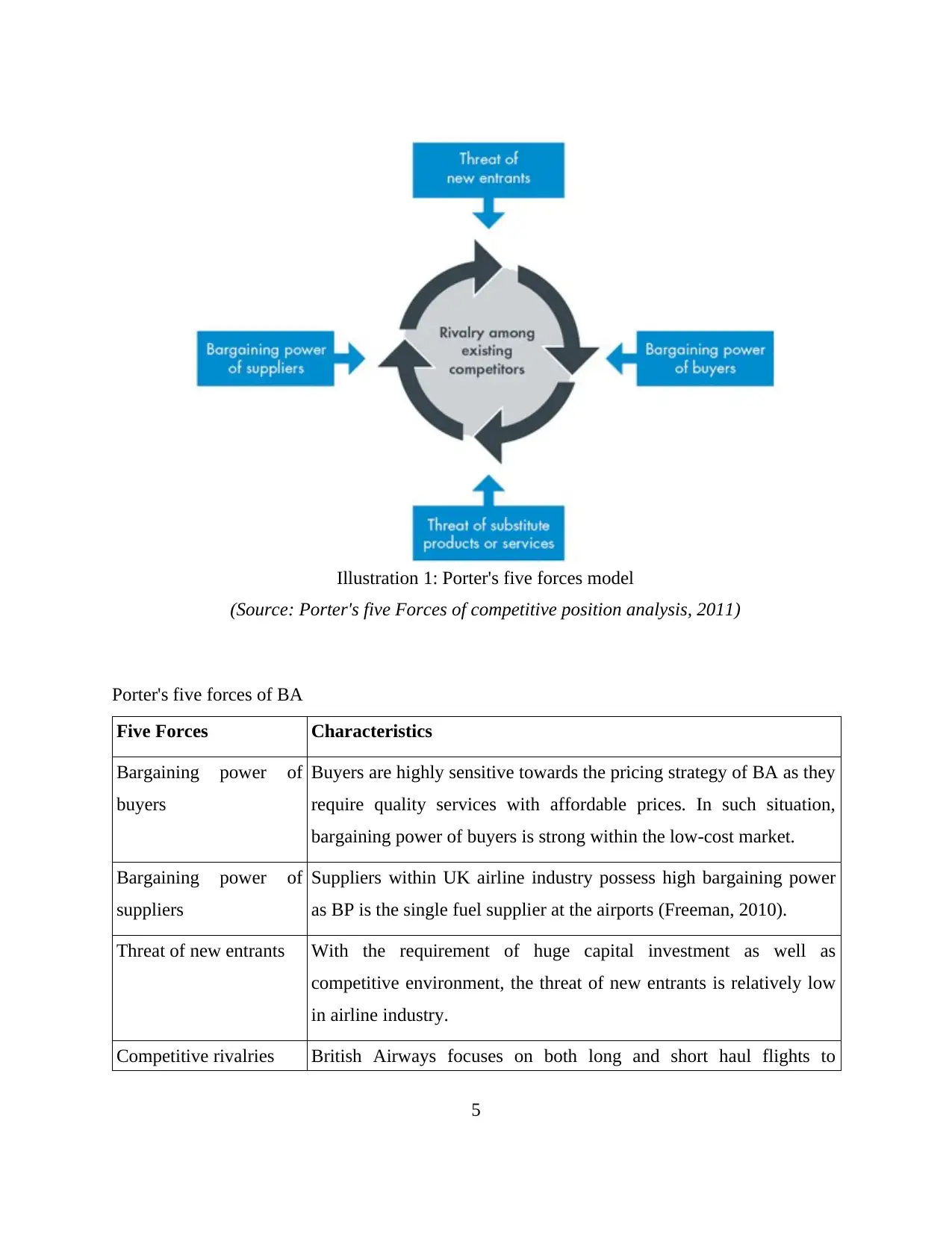
Porter's five forces of BA
Five Forces Characteristics
Bargaining power of
buyers
Buyers are highly sensitive towards the pricing strategy of BA as they
require quality services with affordable prices. In such situation,
bargaining power of buyers is strong within the low-cost market.
Bargaining power of
suppliers
Suppliers within UK airline industry possess high bargaining power
as BP is the single fuel supplier at the airports (Freeman, 2010).
Threat of new entrants With the requirement of huge capital investment as well as
competitive environment, the threat of new entrants is relatively low
in airline industry.
Competitive rivalries British Airways focuses on both long and short haul flights to
5
Illustration 1: Porter's five forces model
(Source: Porter's five Forces of competitive position analysis, 2011)
Five Forces Characteristics
Bargaining power of
buyers
Buyers are highly sensitive towards the pricing strategy of BA as they
require quality services with affordable prices. In such situation,
bargaining power of buyers is strong within the low-cost market.
Bargaining power of
suppliers
Suppliers within UK airline industry possess high bargaining power
as BP is the single fuel supplier at the airports (Freeman, 2010).
Threat of new entrants With the requirement of huge capital investment as well as
competitive environment, the threat of new entrants is relatively low
in airline industry.
Competitive rivalries British Airways focuses on both long and short haul flights to
5
Illustration 1: Porter's five forces model
(Source: Porter's five Forces of competitive position analysis, 2011)
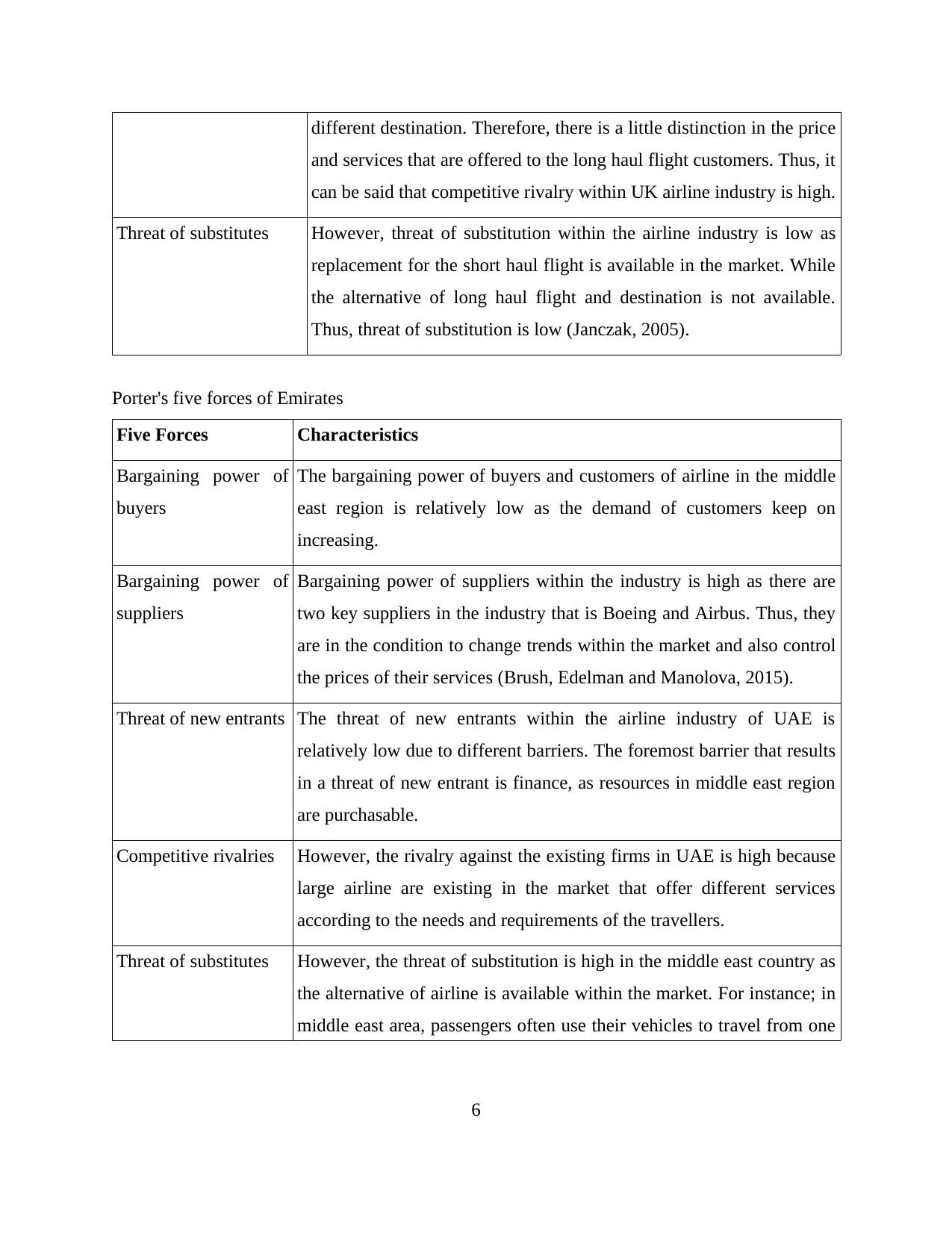
different destination. Therefore, there is a little distinction in the price
and services that are offered to the long haul flight customers. Thus, it
can be said that competitive rivalry within UK airline industry is high.
Threat of substitutes However, threat of substitution within the airline industry is low as
replacement for the short haul flight is available in the market. While
the alternative of long haul flight and destination is not available.
Thus, threat of substitution is low (Janczak, 2005).
Porter's five forces of Emirates
Five Forces Characteristics
Bargaining power of
buyers
The bargaining power of buyers and customers of airline in the middle
east region is relatively low as the demand of customers keep on
increasing.
Bargaining power of
suppliers
Bargaining power of suppliers within the industry is high as there are
two key suppliers in the industry that is Boeing and Airbus. Thus, they
are in the condition to change trends within the market and also control
the prices of their services (Brush, Edelman and Manolova, 2015).
Threat of new entrants The threat of new entrants within the airline industry of UAE is
relatively low due to different barriers. The foremost barrier that results
in a threat of new entrant is finance, as resources in middle east region
are purchasable.
Competitive rivalries However, the rivalry against the existing firms in UAE is high because
large airline are existing in the market that offer different services
according to the needs and requirements of the travellers.
Threat of substitutes However, the threat of substitution is high in the middle east country as
the alternative of airline is available within the market. For instance; in
middle east area, passengers often use their vehicles to travel from one
6
and services that are offered to the long haul flight customers. Thus, it
can be said that competitive rivalry within UK airline industry is high.
Threat of substitutes However, threat of substitution within the airline industry is low as
replacement for the short haul flight is available in the market. While
the alternative of long haul flight and destination is not available.
Thus, threat of substitution is low (Janczak, 2005).
Porter's five forces of Emirates
Five Forces Characteristics
Bargaining power of
buyers
The bargaining power of buyers and customers of airline in the middle
east region is relatively low as the demand of customers keep on
increasing.
Bargaining power of
suppliers
Bargaining power of suppliers within the industry is high as there are
two key suppliers in the industry that is Boeing and Airbus. Thus, they
are in the condition to change trends within the market and also control
the prices of their services (Brush, Edelman and Manolova, 2015).
Threat of new entrants The threat of new entrants within the airline industry of UAE is
relatively low due to different barriers. The foremost barrier that results
in a threat of new entrant is finance, as resources in middle east region
are purchasable.
Competitive rivalries However, the rivalry against the existing firms in UAE is high because
large airline are existing in the market that offer different services
according to the needs and requirements of the travellers.
Threat of substitutes However, the threat of substitution is high in the middle east country as
the alternative of airline is available within the market. For instance; in
middle east area, passengers often use their vehicles to travel from one
6

place to another within the country (De Wit, 2015).
3. INTERNATIONALIZATION
PESTLE analysis of British Airways:
Factors Characteristic
Political factor The political environment is generally concerned with interference of
function of UK government within the operation of BA that directly
affects their working. For instance; with the increase in flight tax rates,
business travelers will also result in paying higher tax that might affect the
customer’s budget.
Economical factor Another factor that affects the operation of BA is economic activity of UK.
For instance; with the inflation rate in UK, customers will not purchase
higher price tickets of flight to travel from one place to another (Forsgren,
2015).
Social factor Another factor is social factor that affect the operations of BA in UK
market that are customers and passengers who are preferring to continue
the long haul flights as compare to the short one. However, now a days for
having quality experience customers are preferring to opt the budgeted
flights according to their changing needs and requirements.
Technological
factor
Technological factor also plays a significant role in the operations of BA.
With the self-service check-in machines available at the airport lounge that
assists passenger to overcome the queuing system. However, with the
increase in airline website, they support BA customers in grabbing the
opportunities to avail the additional discount on their flight fare.
Legal factor However, legal factor also affect BA’s business environment within UK.
There are different legal regulations and norms that are proposed by the
UK government so that they can easily carry out their services and
operation within their region. With the help of safety and regulation act,
7
3. INTERNATIONALIZATION
PESTLE analysis of British Airways:
Factors Characteristic
Political factor The political environment is generally concerned with interference of
function of UK government within the operation of BA that directly
affects their working. For instance; with the increase in flight tax rates,
business travelers will also result in paying higher tax that might affect the
customer’s budget.
Economical factor Another factor that affects the operation of BA is economic activity of UK.
For instance; with the inflation rate in UK, customers will not purchase
higher price tickets of flight to travel from one place to another (Forsgren,
2015).
Social factor Another factor is social factor that affect the operations of BA in UK
market that are customers and passengers who are preferring to continue
the long haul flights as compare to the short one. However, now a days for
having quality experience customers are preferring to opt the budgeted
flights according to their changing needs and requirements.
Technological
factor
Technological factor also plays a significant role in the operations of BA.
With the self-service check-in machines available at the airport lounge that
assists passenger to overcome the queuing system. However, with the
increase in airline website, they support BA customers in grabbing the
opportunities to avail the additional discount on their flight fare.
Legal factor However, legal factor also affect BA’s business environment within UK.
There are different legal regulations and norms that are proposed by the
UK government so that they can easily carry out their services and
operation within their region. With the help of safety and regulation act,
7
Paraphrase This Document
Need a fresh take? Get an instant paraphrase of this document with our AI Paraphraser
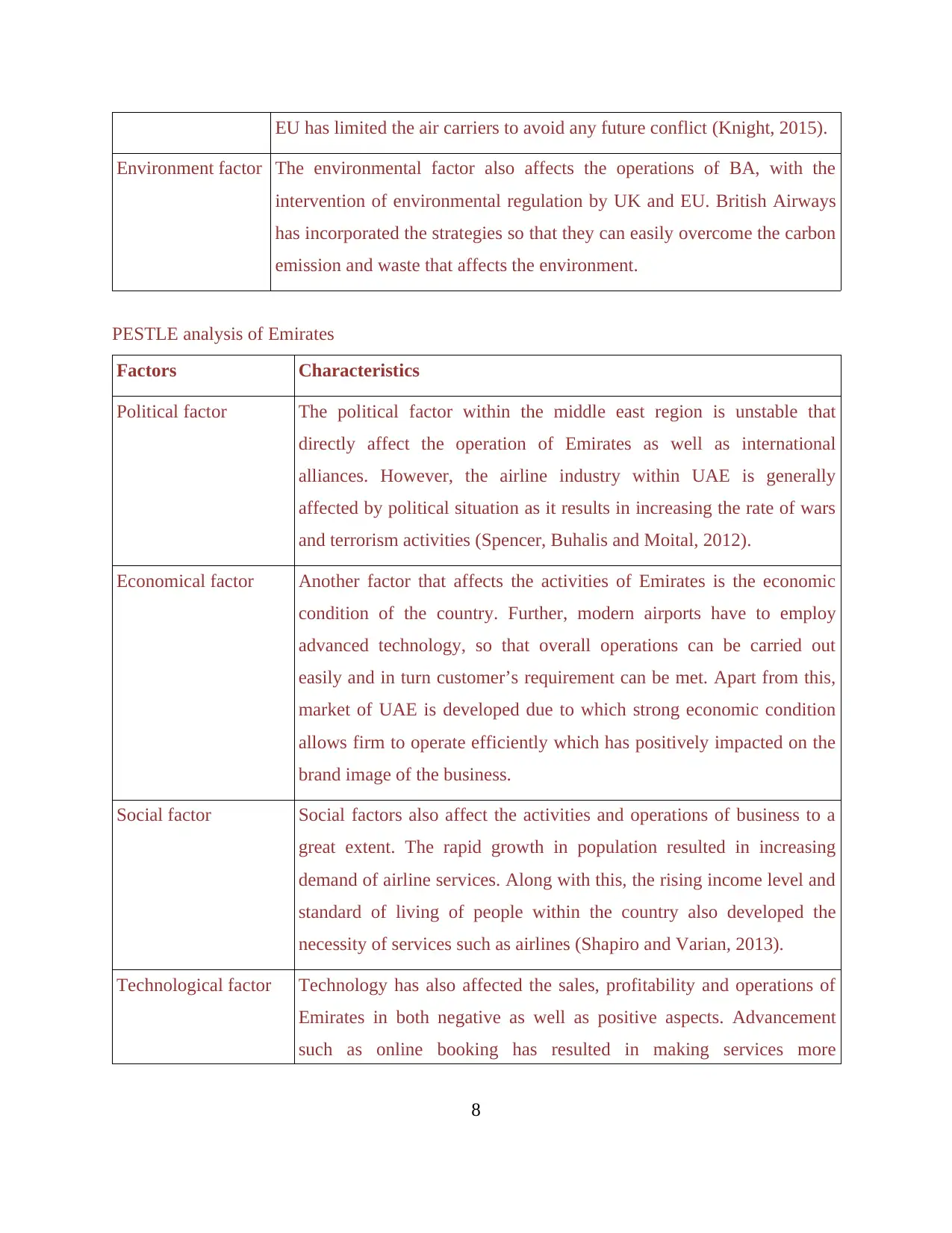
EU has limited the air carriers to avoid any future conflict (Knight, 2015).
Environment factor The environmental factor also affects the operations of BA, with the
intervention of environmental regulation by UK and EU. British Airways
has incorporated the strategies so that they can easily overcome the carbon
emission and waste that affects the environment.
PESTLE analysis of Emirates
Factors Characteristics
Political factor The political factor within the middle east region is unstable that
directly affect the operation of Emirates as well as international
alliances. However, the airline industry within UAE is generally
affected by political situation as it results in increasing the rate of wars
and terrorism activities (Spencer, Buhalis and Moital, 2012).
Economical factor Another factor that affects the activities of Emirates is the economic
condition of the country. Further, modern airports have to employ
advanced technology, so that overall operations can be carried out
easily and in turn customer’s requirement can be met. Apart from this,
market of UAE is developed due to which strong economic condition
allows firm to operate efficiently which has positively impacted on the
brand image of the business.
Social factor Social factors also affect the activities and operations of business to a
great extent. The rapid growth in population resulted in increasing
demand of airline services. Along with this, the rising income level and
standard of living of people within the country also developed the
necessity of services such as airlines (Shapiro and Varian, 2013).
Technological factor Technology has also affected the sales, profitability and operations of
Emirates in both negative as well as positive aspects. Advancement
such as online booking has resulted in making services more
8
Environment factor The environmental factor also affects the operations of BA, with the
intervention of environmental regulation by UK and EU. British Airways
has incorporated the strategies so that they can easily overcome the carbon
emission and waste that affects the environment.
PESTLE analysis of Emirates
Factors Characteristics
Political factor The political factor within the middle east region is unstable that
directly affect the operation of Emirates as well as international
alliances. However, the airline industry within UAE is generally
affected by political situation as it results in increasing the rate of wars
and terrorism activities (Spencer, Buhalis and Moital, 2012).
Economical factor Another factor that affects the activities of Emirates is the economic
condition of the country. Further, modern airports have to employ
advanced technology, so that overall operations can be carried out
easily and in turn customer’s requirement can be met. Apart from this,
market of UAE is developed due to which strong economic condition
allows firm to operate efficiently which has positively impacted on the
brand image of the business.
Social factor Social factors also affect the activities and operations of business to a
great extent. The rapid growth in population resulted in increasing
demand of airline services. Along with this, the rising income level and
standard of living of people within the country also developed the
necessity of services such as airlines (Shapiro and Varian, 2013).
Technological factor Technology has also affected the sales, profitability and operations of
Emirates in both negative as well as positive aspects. Advancement
such as online booking has resulted in making services more
8

convenient for customers. On the other hand, it has increased the cost
because airline is adopting new techniques and machines.
Legal factor Legal laws along with regulations are present in the airline industry
which business has to comply strictly. Laws such as safety, payment of
taxes and other type of duties has to be followed by business. Emirates
strongly comply with guidelines issued by government and this
supports the airline in enhancing its market performance which is
fruitful for business also (Moutinho, 2011).
Environment factor Airlines are having adverse impact on environment due to which large
number of aviation companies has to change their internal policies so
that it is possible to reduce adverse impact on surroundings. Emirates
has started to employ technological tools such as advanced engines
which creates less pollution.
From the above analysis of external environment, with the help of PESTEL, it can be
stated that with the increasing aviation firms, market share of both the companies are gaining
significant pace in the external environment. However, global market is feasible for both the
organizations to enter in different markets by increasing their carrier rates. From the above
analysis, it can be concluded that UK political factor directly affects the operations of BA as
increase in tax rate will result in increasing the charges of flight that further result in influencing
their demand. On the other hand, political factor in UAE is also not stable because of increasing
terrorism activities that directly affects the operations of Emirates in Dubai.
4. DRIVERS OF INTERNATIONALIZATION
George Yip has defined four industry drivers that support the organization in
internationalization of their business activities and operations (Lee, Kim and Park, 2012).
The author has focused on the four key drivers that are market, cost, government and
competitiveness. Market drivers generally focus on assessing the needs and requirements of
customers and passengers that are residing in the global marketplace. However, the cost drivers
9
because airline is adopting new techniques and machines.
Legal factor Legal laws along with regulations are present in the airline industry
which business has to comply strictly. Laws such as safety, payment of
taxes and other type of duties has to be followed by business. Emirates
strongly comply with guidelines issued by government and this
supports the airline in enhancing its market performance which is
fruitful for business also (Moutinho, 2011).
Environment factor Airlines are having adverse impact on environment due to which large
number of aviation companies has to change their internal policies so
that it is possible to reduce adverse impact on surroundings. Emirates
has started to employ technological tools such as advanced engines
which creates less pollution.
From the above analysis of external environment, with the help of PESTEL, it can be
stated that with the increasing aviation firms, market share of both the companies are gaining
significant pace in the external environment. However, global market is feasible for both the
organizations to enter in different markets by increasing their carrier rates. From the above
analysis, it can be concluded that UK political factor directly affects the operations of BA as
increase in tax rate will result in increasing the charges of flight that further result in influencing
their demand. On the other hand, political factor in UAE is also not stable because of increasing
terrorism activities that directly affects the operations of Emirates in Dubai.
4. DRIVERS OF INTERNATIONALIZATION
George Yip has defined four industry drivers that support the organization in
internationalization of their business activities and operations (Lee, Kim and Park, 2012).
The author has focused on the four key drivers that are market, cost, government and
competitiveness. Market drivers generally focus on assessing the needs and requirements of
customers and passengers that are residing in the global marketplace. However, the cost drivers
9

are considered as scale of economies that standardize the needs and opportunities of customers.
Government drivers include eliminating all the tariffs as well as trade policies that are
compatible for the organization to sustain in the airline industry. The last driver of
internationalization comprises of competitive drivers that generally include the strategies of
rivalries in the global marketplace (Luo, Sun and Wang, 2011).
As per the above key forces of globalization, it assists British Airways in growing the
airline industry in the different region and countries. For instance; the first driver in
internationalization is market globalization that is increasing at the fastest pace due to similar
needs and preferences of the global customers. By considering the past scenario, in the present
aspect, passengers are increasing their travelling activities to meet both business and leisure
purpose. However, with the help of economies of scale, cost forces act as the competitive
advantage for British Airways to succeed in the global marketplace. However, the cost drivers
can also be attained by sourcing the fuel and other material from the missing cost suppliers
across the globe. Furthermore, the activities as well as different framed policies of the UK
government have also resulted in driving globalization of airline industry (Lucas, 2010).
However, Emirates also focuses on the Yip component that acts as the force of
internationalization. The company supports open sky policy for encouraging and creating healthy
competition within the industry that gives overall benefit to Emirates by increasing their
efficiency within the industry. Another driver is cost drivers that result in gaining competitive
cost advantage by focusing on the rendering, affordable and luxury air services to the passengers
(Kuratko and Audretsch, 2009). Furthermore, with introducing A380 buses, Emirates have
focused on low cost carrier services that have attracted a large number of customers and
passengers towards their services and travel. With creating or establishing partnership will also
support Emirates in increasing their global customer base. In addition to this, the airline company
is wholly owned by the UAE government therefore, there is a presence of favourable trade
policies, open skies agreement, and regulations that affect their global strategy.
5. BARRIERS IN INTERNATIONALIZATION
Barriers to internationalization have been identified by the Cage. He has defined 4
barriers which hinders the activity of internationalization that is carried out by British Airways
10
Government drivers include eliminating all the tariffs as well as trade policies that are
compatible for the organization to sustain in the airline industry. The last driver of
internationalization comprises of competitive drivers that generally include the strategies of
rivalries in the global marketplace (Luo, Sun and Wang, 2011).
As per the above key forces of globalization, it assists British Airways in growing the
airline industry in the different region and countries. For instance; the first driver in
internationalization is market globalization that is increasing at the fastest pace due to similar
needs and preferences of the global customers. By considering the past scenario, in the present
aspect, passengers are increasing their travelling activities to meet both business and leisure
purpose. However, with the help of economies of scale, cost forces act as the competitive
advantage for British Airways to succeed in the global marketplace. However, the cost drivers
can also be attained by sourcing the fuel and other material from the missing cost suppliers
across the globe. Furthermore, the activities as well as different framed policies of the UK
government have also resulted in driving globalization of airline industry (Lucas, 2010).
However, Emirates also focuses on the Yip component that acts as the force of
internationalization. The company supports open sky policy for encouraging and creating healthy
competition within the industry that gives overall benefit to Emirates by increasing their
efficiency within the industry. Another driver is cost drivers that result in gaining competitive
cost advantage by focusing on the rendering, affordable and luxury air services to the passengers
(Kuratko and Audretsch, 2009). Furthermore, with introducing A380 buses, Emirates have
focused on low cost carrier services that have attracted a large number of customers and
passengers towards their services and travel. With creating or establishing partnership will also
support Emirates in increasing their global customer base. In addition to this, the airline company
is wholly owned by the UAE government therefore, there is a presence of favourable trade
policies, open skies agreement, and regulations that affect their global strategy.
5. BARRIERS IN INTERNATIONALIZATION
Barriers to internationalization have been identified by the Cage. He has defined 4
barriers which hinders the activity of internationalization that is carried out by British Airways
10
Secure Best Marks with AI Grader
Need help grading? Try our AI Grader for instant feedback on your assignments.
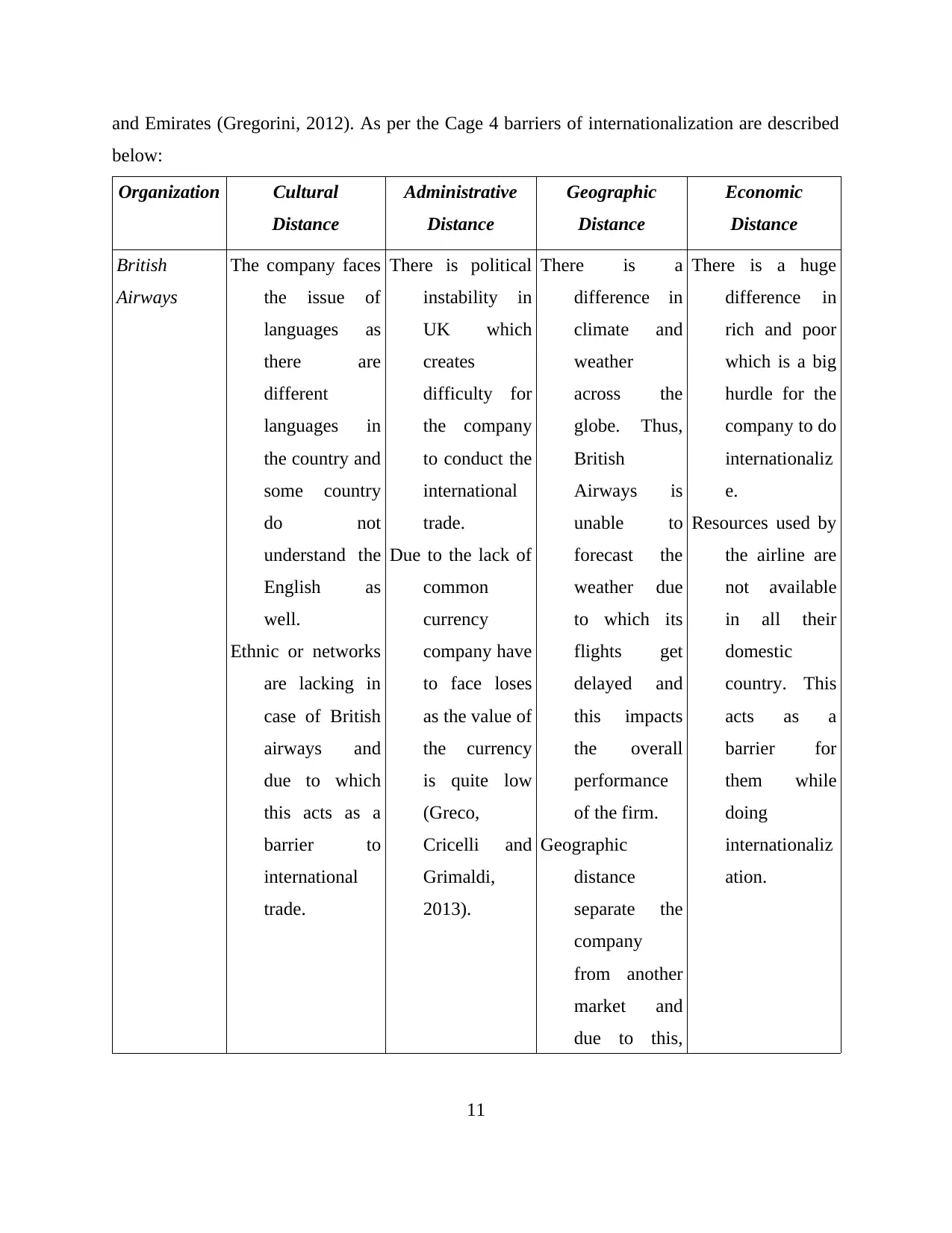
and Emirates (Gregorini, 2012). As per the Cage 4 barriers of internationalization are described
below:
Organization Cultural
Distance
Administrative
Distance
Geographic
Distance
Economic
Distance
British
Airways
The company faces
the issue of
languages as
there are
different
languages in
the country and
some country
do not
understand the
English as
well.
Ethnic or networks
are lacking in
case of British
airways and
due to which
this acts as a
barrier to
international
trade.
There is political
instability in
UK which
creates
difficulty for
the company
to conduct the
international
trade.
Due to the lack of
common
currency
company have
to face loses
as the value of
the currency
is quite low
(Greco,
Cricelli and
Grimaldi,
2013).
There is a
difference in
climate and
weather
across the
globe. Thus,
British
Airways is
unable to
forecast the
weather due
to which its
flights get
delayed and
this impacts
the overall
performance
of the firm.
Geographic
distance
separate the
company
from another
market and
due to this,
There is a huge
difference in
rich and poor
which is a big
hurdle for the
company to do
internationaliz
e.
Resources used by
the airline are
not available
in all their
domestic
country. This
acts as a
barrier for
them while
doing
internationaliz
ation.
11
below:
Organization Cultural
Distance
Administrative
Distance
Geographic
Distance
Economic
Distance
British
Airways
The company faces
the issue of
languages as
there are
different
languages in
the country and
some country
do not
understand the
English as
well.
Ethnic or networks
are lacking in
case of British
airways and
due to which
this acts as a
barrier to
international
trade.
There is political
instability in
UK which
creates
difficulty for
the company
to conduct the
international
trade.
Due to the lack of
common
currency
company have
to face loses
as the value of
the currency
is quite low
(Greco,
Cricelli and
Grimaldi,
2013).
There is a
difference in
climate and
weather
across the
globe. Thus,
British
Airways is
unable to
forecast the
weather due
to which its
flights get
delayed and
this impacts
the overall
performance
of the firm.
Geographic
distance
separate the
company
from another
market and
due to this,
There is a huge
difference in
rich and poor
which is a big
hurdle for the
company to do
internationaliz
e.
Resources used by
the airline are
not available
in all their
domestic
country. This
acts as a
barrier for
them while
doing
internationaliz
ation.
11
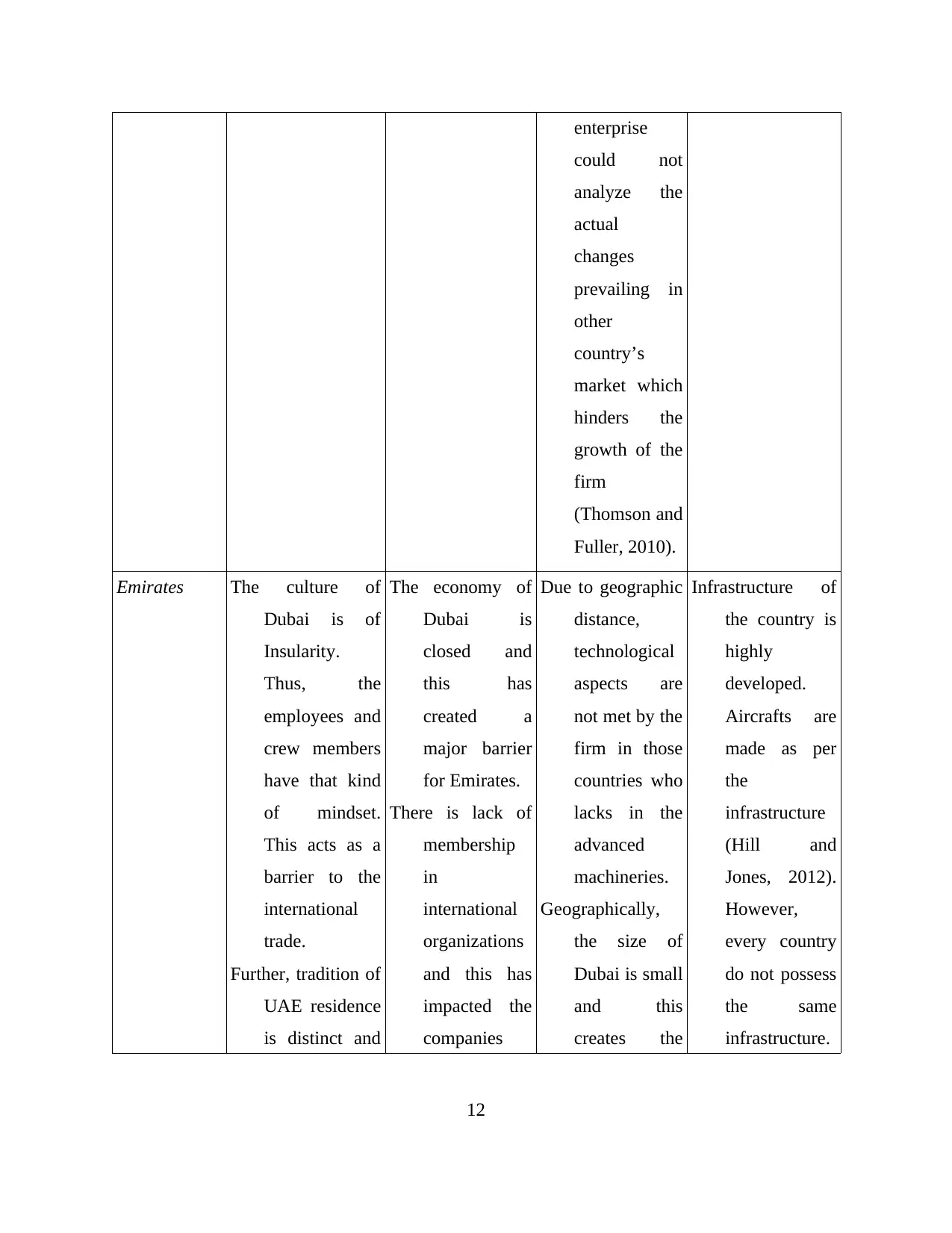
enterprise
could not
analyze the
actual
changes
prevailing in
other
country’s
market which
hinders the
growth of the
firm
(Thomson and
Fuller, 2010).
Emirates The culture of
Dubai is of
Insularity.
Thus, the
employees and
crew members
have that kind
of mindset.
This acts as a
barrier to the
international
trade.
Further, tradition of
UAE residence
is distinct and
The economy of
Dubai is
closed and
this has
created a
major barrier
for Emirates.
There is lack of
membership
in
international
organizations
and this has
impacted the
companies
Due to geographic
distance,
technological
aspects are
not met by the
firm in those
countries who
lacks in the
advanced
machineries.
Geographically,
the size of
Dubai is small
and this
creates the
Infrastructure of
the country is
highly
developed.
Aircrafts are
made as per
the
infrastructure
(Hill and
Jones, 2012).
However,
every country
do not possess
the same
infrastructure.
12
could not
analyze the
actual
changes
prevailing in
other
country’s
market which
hinders the
growth of the
firm
(Thomson and
Fuller, 2010).
Emirates The culture of
Dubai is of
Insularity.
Thus, the
employees and
crew members
have that kind
of mindset.
This acts as a
barrier to the
international
trade.
Further, tradition of
UAE residence
is distinct and
The economy of
Dubai is
closed and
this has
created a
major barrier
for Emirates.
There is lack of
membership
in
international
organizations
and this has
impacted the
companies
Due to geographic
distance,
technological
aspects are
not met by the
firm in those
countries who
lacks in the
advanced
machineries.
Geographically,
the size of
Dubai is small
and this
creates the
Infrastructure of
the country is
highly
developed.
Aircrafts are
made as per
the
infrastructure
(Hill and
Jones, 2012).
However,
every country
do not possess
the same
infrastructure.
12
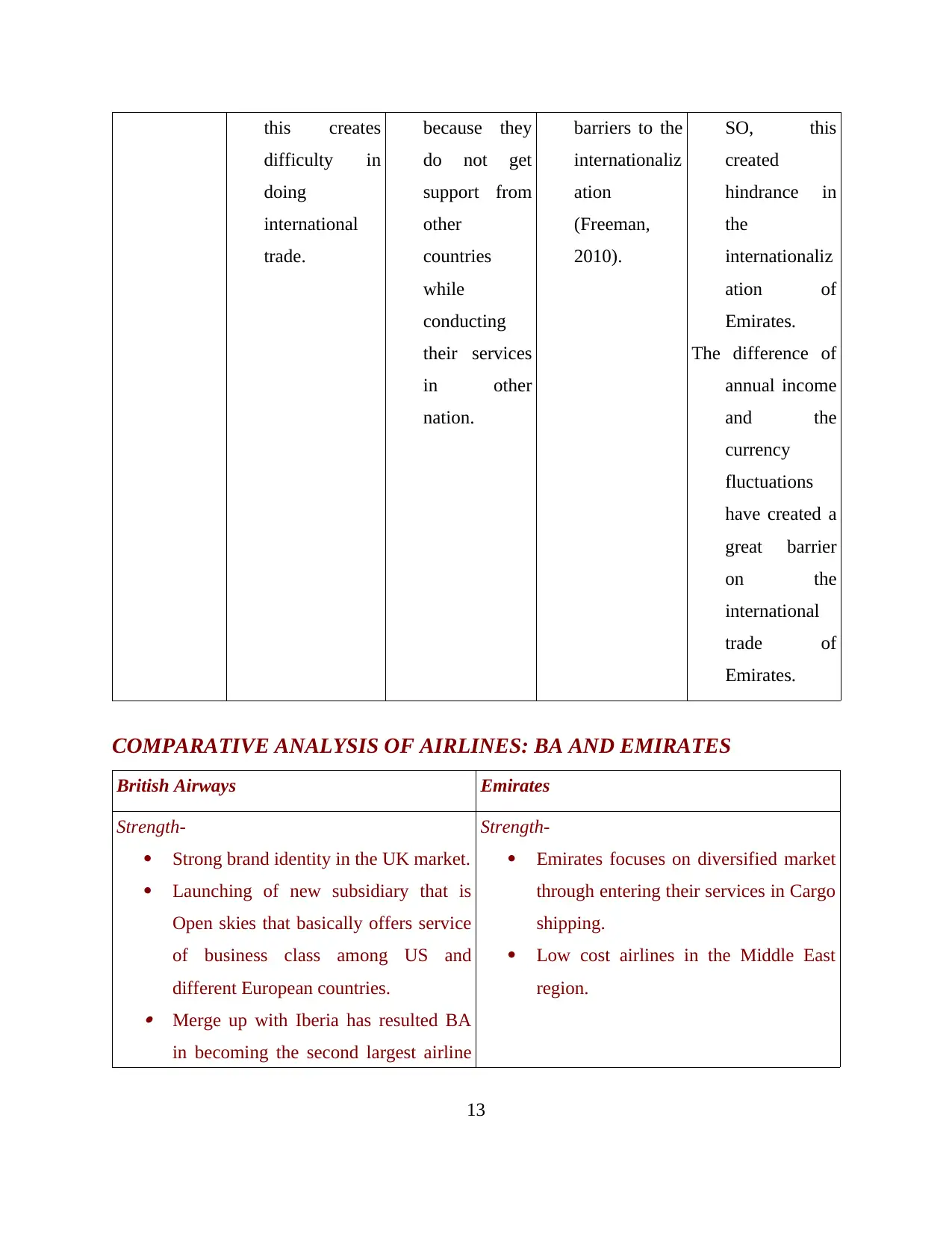
this creates
difficulty in
doing
international
trade.
because they
do not get
support from
other
countries
while
conducting
their services
in other
nation.
barriers to the
internationaliz
ation
(Freeman,
2010).
SO, this
created
hindrance in
the
internationaliz
ation of
Emirates.
The difference of
annual income
and the
currency
fluctuations
have created a
great barrier
on the
international
trade of
Emirates.
COMPARATIVE ANALYSIS OF AIRLINES: BA AND EMIRATES
British Airways Emirates
Strength-
Strong brand identity in the UK market.
Launching of new subsidiary that is
Open skies that basically offers service
of business class among US and
different European countries. Merge up with Iberia has resulted BA
in becoming the second largest airline
Strength-
Emirates focuses on diversified market
through entering their services in Cargo
shipping.
Low cost airlines in the Middle East
region.
13
difficulty in
doing
international
trade.
because they
do not get
support from
other
countries
while
conducting
their services
in other
nation.
barriers to the
internationaliz
ation
(Freeman,
2010).
SO, this
created
hindrance in
the
internationaliz
ation of
Emirates.
The difference of
annual income
and the
currency
fluctuations
have created a
great barrier
on the
international
trade of
Emirates.
COMPARATIVE ANALYSIS OF AIRLINES: BA AND EMIRATES
British Airways Emirates
Strength-
Strong brand identity in the UK market.
Launching of new subsidiary that is
Open skies that basically offers service
of business class among US and
different European countries. Merge up with Iberia has resulted BA
in becoming the second largest airline
Strength-
Emirates focuses on diversified market
through entering their services in Cargo
shipping.
Low cost airlines in the Middle East
region.
13
Paraphrase This Document
Need a fresh take? Get an instant paraphrase of this document with our AI Paraphraser
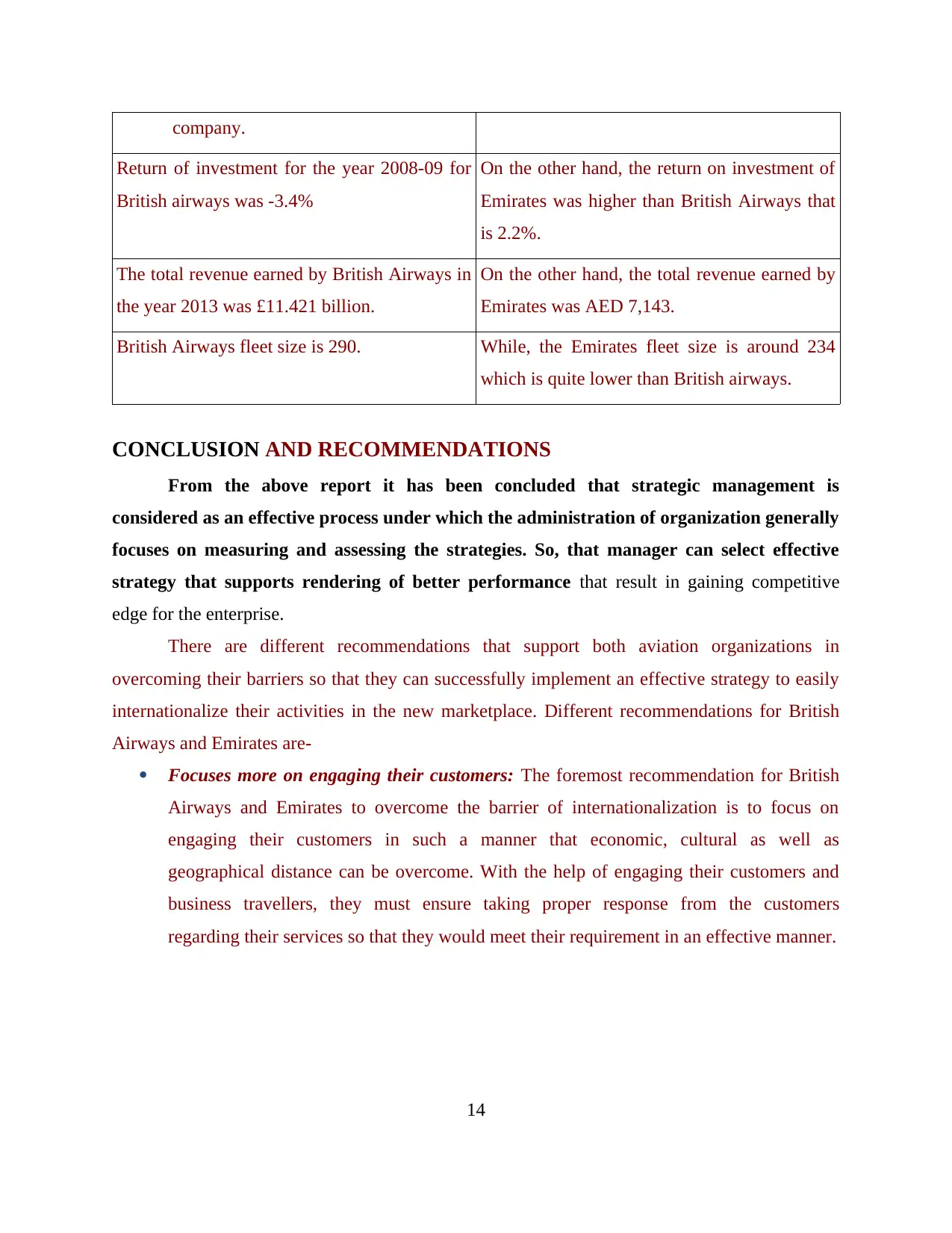
company.
Return of investment for the year 2008-09 for
British airways was -3.4%
On the other hand, the return on investment of
Emirates was higher than British Airways that
is 2.2%.
The total revenue earned by British Airways in
the year 2013 was £11.421 billion.
On the other hand, the total revenue earned by
Emirates was AED 7,143.
British Airways fleet size is 290. While, the Emirates fleet size is around 234
which is quite lower than British airways.
CONCLUSION AND RECOMMENDATIONS
From the above report it has been concluded that strategic management is
considered as an effective process under which the administration of organization generally
focuses on measuring and assessing the strategies. So, that manager can select effective
strategy that supports rendering of better performance that result in gaining competitive
edge for the enterprise.
There are different recommendations that support both aviation organizations in
overcoming their barriers so that they can successfully implement an effective strategy to easily
internationalize their activities in the new marketplace. Different recommendations for British
Airways and Emirates are-
Focuses more on engaging their customers: The foremost recommendation for British
Airways and Emirates to overcome the barrier of internationalization is to focus on
engaging their customers in such a manner that economic, cultural as well as
geographical distance can be overcome. With the help of engaging their customers and
business travellers, they must ensure taking proper response from the customers
regarding their services so that they would meet their requirement in an effective manner.
14
Return of investment for the year 2008-09 for
British airways was -3.4%
On the other hand, the return on investment of
Emirates was higher than British Airways that
is 2.2%.
The total revenue earned by British Airways in
the year 2013 was £11.421 billion.
On the other hand, the total revenue earned by
Emirates was AED 7,143.
British Airways fleet size is 290. While, the Emirates fleet size is around 234
which is quite lower than British airways.
CONCLUSION AND RECOMMENDATIONS
From the above report it has been concluded that strategic management is
considered as an effective process under which the administration of organization generally
focuses on measuring and assessing the strategies. So, that manager can select effective
strategy that supports rendering of better performance that result in gaining competitive
edge for the enterprise.
There are different recommendations that support both aviation organizations in
overcoming their barriers so that they can successfully implement an effective strategy to easily
internationalize their activities in the new marketplace. Different recommendations for British
Airways and Emirates are-
Focuses more on engaging their customers: The foremost recommendation for British
Airways and Emirates to overcome the barrier of internationalization is to focus on
engaging their customers in such a manner that economic, cultural as well as
geographical distance can be overcome. With the help of engaging their customers and
business travellers, they must ensure taking proper response from the customers
regarding their services so that they would meet their requirement in an effective manner.
14
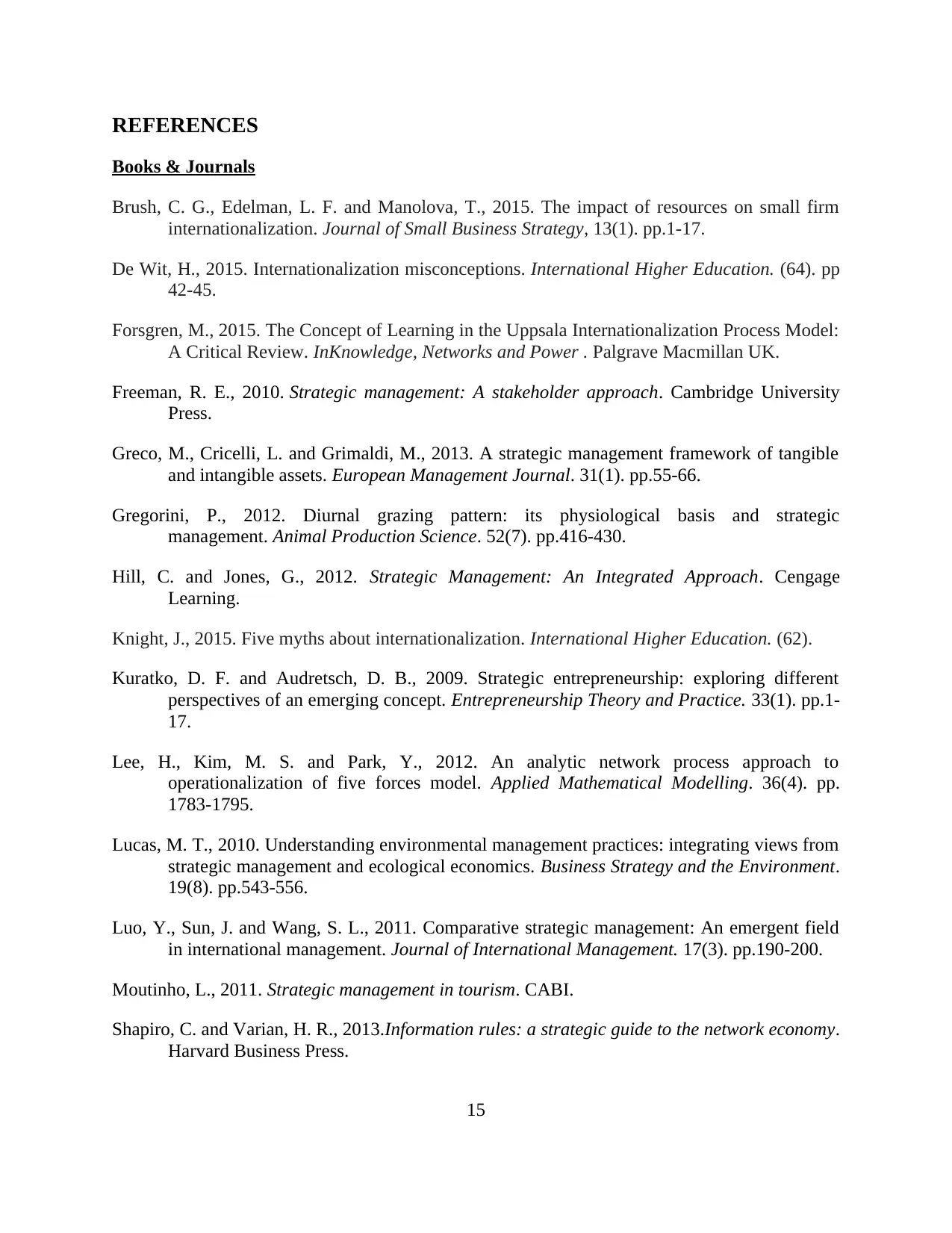
REFERENCES
Books & Journals
Brush, C. G., Edelman, L. F. and Manolova, T., 2015. The impact of resources on small firm
internationalization. Journal of Small Business Strategy, 13(1). pp.1-17.
De Wit, H., 2015. Internationalization misconceptions. International Higher Education. (64). pp
42-45.
Forsgren, M., 2015. The Concept of Learning in the Uppsala Internationalization Process Model:
A Critical Review. InKnowledge, Networks and Power . Palgrave Macmillan UK.
Freeman, R. E., 2010. Strategic management: A stakeholder approach. Cambridge University
Press.
Greco, M., Cricelli, L. and Grimaldi, M., 2013. A strategic management framework of tangible
and intangible assets. European Management Journal. 31(1). pp.55-66.
Gregorini, P., 2012. Diurnal grazing pattern: its physiological basis and strategic
management. Animal Production Science. 52(7). pp.416-430.
Hill, C. and Jones, G., 2012. Strategic Management: An Integrated Approach. Cengage
Learning.
Knight, J., 2015. Five myths about internationalization. International Higher Education. (62).
Kuratko, D. F. and Audretsch, D. B., 2009. Strategic entrepreneurship: exploring different
perspectives of an emerging concept. Entrepreneurship Theory and Practice. 33(1). pp.1-
17.
Lee, H., Kim, M. S. and Park, Y., 2012. An analytic network process approach to
operationalization of five forces model. Applied Mathematical Modelling. 36(4). pp.
1783-1795.
Lucas, M. T., 2010. Understanding environmental management practices: integrating views from
strategic management and ecological economics. Business Strategy and the Environment.
19(8). pp.543-556.
Luo, Y., Sun, J. and Wang, S. L., 2011. Comparative strategic management: An emergent field
in international management. Journal of International Management. 17(3). pp.190-200.
Moutinho, L., 2011. Strategic management in tourism. CABI.
Shapiro, C. and Varian, H. R., 2013.Information rules: a strategic guide to the network economy.
Harvard Business Press.
15
Books & Journals
Brush, C. G., Edelman, L. F. and Manolova, T., 2015. The impact of resources on small firm
internationalization. Journal of Small Business Strategy, 13(1). pp.1-17.
De Wit, H., 2015. Internationalization misconceptions. International Higher Education. (64). pp
42-45.
Forsgren, M., 2015. The Concept of Learning in the Uppsala Internationalization Process Model:
A Critical Review. InKnowledge, Networks and Power . Palgrave Macmillan UK.
Freeman, R. E., 2010. Strategic management: A stakeholder approach. Cambridge University
Press.
Greco, M., Cricelli, L. and Grimaldi, M., 2013. A strategic management framework of tangible
and intangible assets. European Management Journal. 31(1). pp.55-66.
Gregorini, P., 2012. Diurnal grazing pattern: its physiological basis and strategic
management. Animal Production Science. 52(7). pp.416-430.
Hill, C. and Jones, G., 2012. Strategic Management: An Integrated Approach. Cengage
Learning.
Knight, J., 2015. Five myths about internationalization. International Higher Education. (62).
Kuratko, D. F. and Audretsch, D. B., 2009. Strategic entrepreneurship: exploring different
perspectives of an emerging concept. Entrepreneurship Theory and Practice. 33(1). pp.1-
17.
Lee, H., Kim, M. S. and Park, Y., 2012. An analytic network process approach to
operationalization of five forces model. Applied Mathematical Modelling. 36(4). pp.
1783-1795.
Lucas, M. T., 2010. Understanding environmental management practices: integrating views from
strategic management and ecological economics. Business Strategy and the Environment.
19(8). pp.543-556.
Luo, Y., Sun, J. and Wang, S. L., 2011. Comparative strategic management: An emergent field
in international management. Journal of International Management. 17(3). pp.190-200.
Moutinho, L., 2011. Strategic management in tourism. CABI.
Shapiro, C. and Varian, H. R., 2013.Information rules: a strategic guide to the network economy.
Harvard Business Press.
15

Spencer, A. J., Buhalis, D. and Moital, M., 2012. A hierarchical model of technology adoption
for small owner-managed travel firms: An organizational decision-making and leadership
perspective. Tourism Management. 33(5). pp. 1195-1208.
Thomson, N. and Fuller, B. C., 2010. Basic Strategy in Context: European text and cases. John
Wiley & Sons.
Online
Janczak, S., 2005. The Strategic Decision-Making Process in Organizations. [Pdf]. Available
through:
<http://businessperspectives.org/journals_free/ppm/2005/PPM_EN_2005_03_Janczak.pd
f>. [Accessed on 6th February 2016].
Porter's Five Forces of competitive position analysis. 2011. [Online]. Available through:
<http://www.cgma.org/Resources/Tools/essential-tools/Pages/porters-five-forces.aspx?
TestCookiesEnabled=redirect>. [Accessed on 29th February 2016].
16
for small owner-managed travel firms: An organizational decision-making and leadership
perspective. Tourism Management. 33(5). pp. 1195-1208.
Thomson, N. and Fuller, B. C., 2010. Basic Strategy in Context: European text and cases. John
Wiley & Sons.
Online
Janczak, S., 2005. The Strategic Decision-Making Process in Organizations. [Pdf]. Available
through:
<http://businessperspectives.org/journals_free/ppm/2005/PPM_EN_2005_03_Janczak.pd
f>. [Accessed on 6th February 2016].
Porter's Five Forces of competitive position analysis. 2011. [Online]. Available through:
<http://www.cgma.org/Resources/Tools/essential-tools/Pages/porters-five-forces.aspx?
TestCookiesEnabled=redirect>. [Accessed on 29th February 2016].
16
1 out of 16
Related Documents
Your All-in-One AI-Powered Toolkit for Academic Success.
+13062052269
info@desklib.com
Available 24*7 on WhatsApp / Email
![[object Object]](/_next/static/media/star-bottom.7253800d.svg)
Unlock your academic potential
© 2024 | Zucol Services PVT LTD | All rights reserved.




